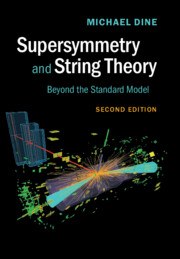Book contents
- Frontmatter
- Dedication
- Contents
- Preface to the First Edition
- Preface to the Second Edition
- A note on the choice of metric
- Text website
- Part 1 Effective field theory: the StandardModel, supersymmetry, unification
- Part 2 Supersymmetry
- Part 3 String theory
- 20 Introduction
- 21 The bosonic string
- 22 The superstring
- 23 The heterotic string
- 24 Effective actions in ten dimensions
- 25 Compactification of string theory I. Tori and orbifolds
- 26 Compactification of string theory II. Calabi–Yau compactifications
- 27 Dynamics of string theory at weak coupling
- 28 Beyond weak coupling: non-perturbative string theory
- 29 Large and warped extra dimensions
- 30 The landscape: a challenge to the naturalness principle
- 31 Coda: Where are we heading?
- Part 4 Appendices
- References
- Index
31 - Coda: Where are we heading?
from Part 3 - String theory
- Frontmatter
- Dedication
- Contents
- Preface to the First Edition
- Preface to the Second Edition
- A note on the choice of metric
- Text website
- Part 1 Effective field theory: the StandardModel, supersymmetry, unification
- Part 2 Supersymmetry
- Part 3 String theory
- 20 Introduction
- 21 The bosonic string
- 22 The superstring
- 23 The heterotic string
- 24 Effective actions in ten dimensions
- 25 Compactification of string theory I. Tori and orbifolds
- 26 Compactification of string theory II. Calabi–Yau compactifications
- 27 Dynamics of string theory at weak coupling
- 28 Beyond weak coupling: non-perturbative string theory
- 29 Large and warped extra dimensions
- 30 The landscape: a challenge to the naturalness principle
- 31 Coda: Where are we heading?
- Part 4 Appendices
- References
- Index
Summary
The LHC, in its first years of running, has been a remarkable success. The discovery of the Higgs boson in an extremely complex environment is an extraordinary achievement, both experimentally and also in the application of our understanding of many facets of the Standard Model. This particle appears, at the 10%−20% level, in several channels, to be the Higgs field of the simplest version of the Standard Model. Over the next few years these measurements will improve and additional channels will be studied. In Chapter 4 of this text we studied the Standard Model as an effective-field theory. In that discussion our treatment of the Higgs sector was somewhat tentative; we entertained the possibility that the Standard Model might fail at scales of order 1 TeV. It is quite possible, however, that over the next few years we will establish that the Standard Model, including only a single Higgs doublet, provides a complete description of nature up to a scale of a few TeV. This would represent an extraordinary achievement.
Yet we have many unanswered questions. As this book goes to press the LHC is beginning to run at close to its design energy of 14 TeV. It is quite possible that, as we explore this new energy frontier, we will see one or more major discoveries – a candidate for dark matter, evidence for supersymmetry, additional Higgs fields, a new U(1) gauge boson Z′ or something totally unanticipated. Experiments at the cosmic frontier searching for dark matter, CMB polarization or non-Gaussianity and other phenomena are coming on line and/or improving their reach, and major discoveries might be made over the next few years. Alternatively we have seen that the LHC has already excluded many possibilities for new physics. It is conceivable that the answers to many questions do not lie at energies which will be accessible in the next few years.
To conclude this book, an assessment of some of the ideas for Beyond the Standard Model physics, and their prospects, is appropriate.
The hierarchy or naturalness problem
The hierarchy problem is strongly suggestive of new physics at TeV energy scales. Supersymmetry, broken at around one TeV, is a possible solution which we have explored extensively in this book.
- Type
- Chapter
- Information
- Supersymmetry and String TheoryBeyond the Standard Model, pp. 444 - 448Publisher: Cambridge University PressPrint publication year: 2016



